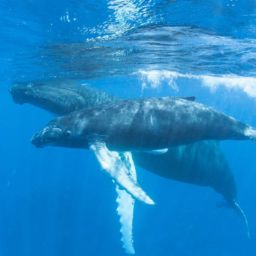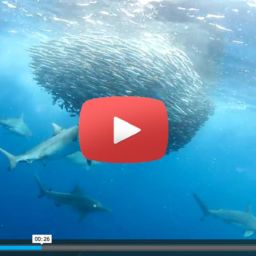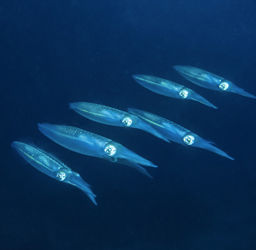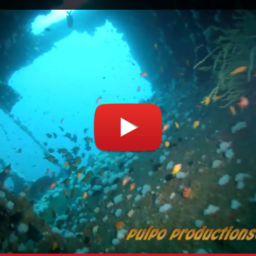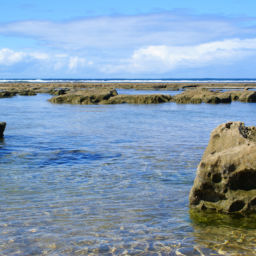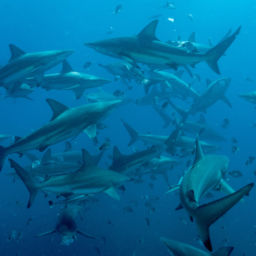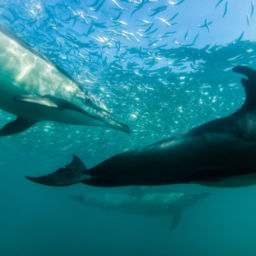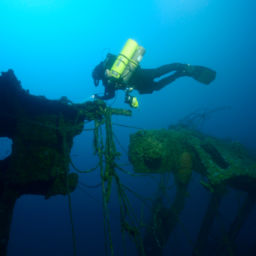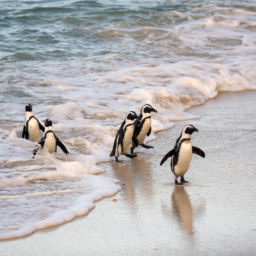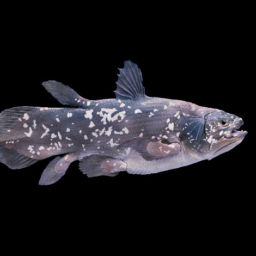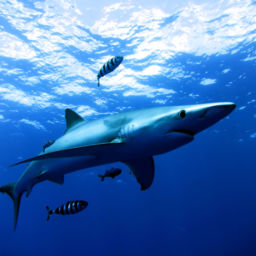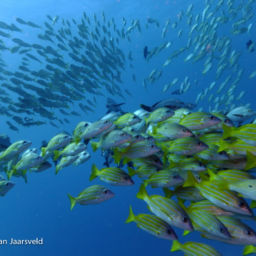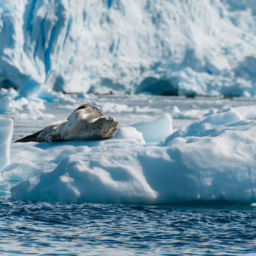You’ll cover some serious nautical miles to spend the day diving with blue and mako sharks in South Africa off Cape Point, but it’s a day well spent for any ocean enthusiast.
Venturing 35 nautical miles offshore to find sharks means that you must keep an open mind. It’s like finding a needle in a haystack, when the haystack could contain a miscellany of other wild surprises. You may see super pods of dusky dolphins, common dolphins, bottlenose dolphins, killer whales, false killer whales, baleen whales, and pelagic bird life, and the list goes on.
The pelagic season in False Bay is open from November until June, and the trip belongs on every diver’s bucket list. Nothing compares to the exhilaration of diving with pelagic sharks many miles from land — the open sea is full of possibility.
The early bird finds the sharks
The day starts at 6:30 a.m. when you will meet the determined crew at Shark Explorers in Simonstown, Cape Town. Coffee and paperwork on arrival will be followed by gear fitting (if you need rental gear). The boat, built and designed for the open ocean, launches at 7:30 a.m. You’ll spend a comfortable 45-minute boat ride passing Boulders Beach and Millers Point, along with the lush green mountains, as you make your way to Cape Point, the most southwesterly tip of Africa. Upon arrival at Cape Point, you’ll stop briefly for some selfies and a snack in preparation for the long voyage ahead.
Now, it’s time to head off in search of the Agulhas Current, where you’re most likely to find pelagic sharks and other life. Depending on the weather conditions, this warm band of water can be as close as 20 nautical miles away from shore or as far as 50 nautical miles.
As with most shark dives, operators use chum to create an oil slick, accompanied by a chum drum hanging at a depth of 16 feet (5 m) to attract sharks. It is open ocean, so the crew might need to move from one spot to another in search of sharks. The waiting period can take anywhere from 10 minutes to 4 hours, so get comfortable, get chatting with your fellow dive buddies, and be ready.
The first arrival will most likely be a blue shark, and one blue shark means that another one should arrive within minutes. Once the divemaster sees that the blue shark is showing interest in the chum drum, it’s time to gear up. Blue sharks may appear here in multiples, so you may dive with as few as two and as many as 10 to 15 on a single dive. Mako sharks may only arrive later on in the dive. Being cautious and skittish about noise and scuba bubbles, they will usually keep a distance and move much faster than blue sharks. You will most likely get to witness one to three on a dive if they do show up.
It is important to pay attention to your divemaster’s briefing before getting in the water. Blue sharks spend most of their time cruising the pelagic ocean without food or any other species interactions, let alone people, for days on end. This means that they will want to see what you are and why you’re in their waters. Acting extremely interactive and social toward divers means that you, as a diver, will have to interact with them too. If they want to have a closer look, you can respectfully give them a gentle push on the nose into the other direction. Do not poke them in the eye or gills — a push on the nose will do the job.
Ready, set, dive
As soon as the moment arrives to enter the water, the guide will loosen the buoy with the chum drum from the boat. You will conduct your dive around the drum and the line connecting it to the boat. As you descend, you will see a streamlined 6.5-foot (2 m) figure coming your way. Colored with various shades of metallic dark blue, dustings of gold, and animated facial features, a blue shark will approach to see who and what you are. This will be the part where you start interacting with a gentle push on its nose, only if necessary. Another blue shark and perhaps a few more will likely come your way.
As you and the sharks become more comfortable with each other, this will turn into one of your most memorable dives. And, just when you think you’ve seen it all, a mako might appear in the distance. It will cautiously circle the group and, once it’s comfortable, it will likely come in for a closer look. Being the cousin of the great white shark — and the fastest shark ever recorded in the ocean — it might look like an intimidating encounter. It will usually be swift, however, as makos are not as fond of interacting with divers as blue sharks are. Safety-wise, operators strongly recommend that divers gear up in all black, as these sharks are sensitive to color. With bright gear, such as fins or gloves, you will attract a lot of attention to yourself.
Just like all dives, this dive must come to an end. A trip like this will only be possible on one tank, as the time it can take to attract sharks is unpredictable and it can be quite far back to land. Your dive time, though, can last anywhere between 45 to 120 minutes. This depends largely on how comfortable you are and how much experience you have.After the dive, it’s time to head home. Once Cape Point appears on the horizon, it’s like the mountains are welcoming you back with open arms.


